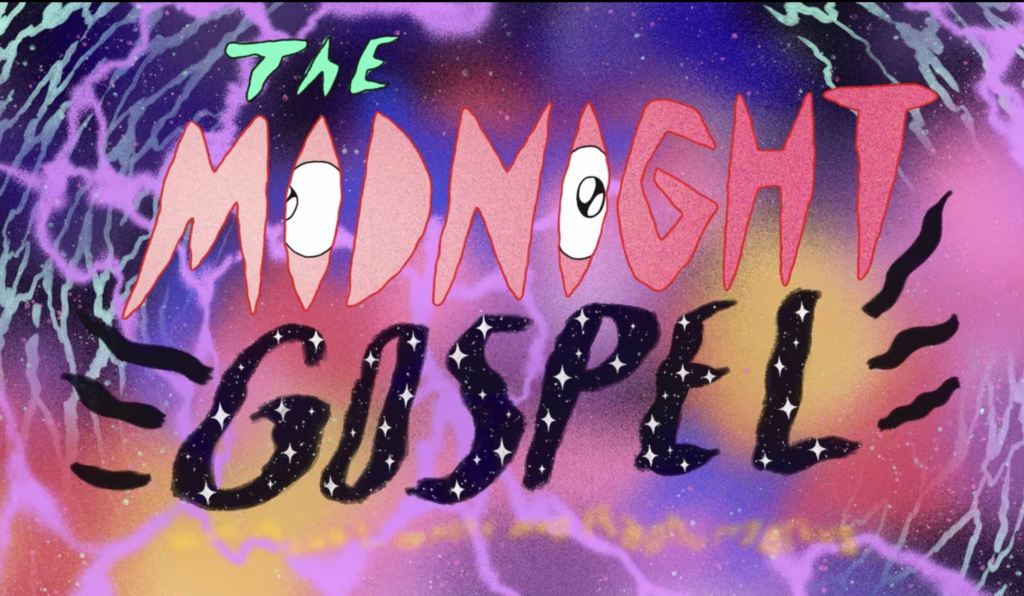
While some of the topics I have detailed on this site drift into our current age, my academic focus tends to be on the Medieval and Renaissance eras. That being said, I can’t help but view modern media that showcases magic, occultism, and esoterica with a critical eye. I don’t expect one hundred percent accuracy, rather, I look for authenticity. I’m sure any historians in the audience are nodding their heads in agreement. For those unfamiliar with the distinction, when a film, novel, or other piece of media bases their content on historical figures or time periods, accuracy would refer to making sure every event, line of dialogue, set piece, costume, etc., reflects what actually occurred. Most blockbusters aren’t concerned with accuracy because they value spectacle and story over intricate details the majority of moviegoers wouldn’t even notice. Particularly egregious examples include Mel Gibson’s Braveheart and Apocalypto which both play fast and loose with history to the extent that they are neither accurate nor authentic.
Neither historical accuracy nor authenticity guarantee a compelling story or a moving work of art, however. This is why one or both are often jettisoned during the creative process. Occult studies, however, is a living art. The spiritual aspects and individualistic nature of its philosophy aspire to authenticity over accuracy far more than any mainstream religion. Gnostics were labeled as heretics for exactly this reason. They prioritized wisdom discovered by the self over the law of the church. In my experience, modern mainstream media doesn’t invest in the authenticity of occultism despite the low bar of admission. Most creators are happy to loot the vaguely satanic or Lovecraftian elements for their low budget horror movie and call it a day. I would be hard pressed to name any movie or series that was genuinely authentic with its occult or esoteric content (Aronofsky’s film The Fountain is one of the few, along with As Above, So Below which largely stays true to occult philosophy while being rather dull and unsuccessful as a movie). This is why I feel compelled to include this page despite it being somewhat off topic.
The Midnight Gospel is a truly unique experience in so many ways. Its premise alone is something so unusual I didn’t even catch on until the second episode of its, so far, brief eight episode run. The bright, energetic, and undeniably trippy animation are provided by the renowned Pendleton Ward (creator of Adventure Time). This might lead the viewer to assume this series is nothing more than a modern Yellow Submarine, something to be consumed along with psychedelics, empty of anything more compelling. While not entirely off base (the first episode is indeed about illicit substances) anyone looking for simple background animations to accompany a leisurely trip will get much more than they expected.
Ward’s animation is set to audio from fellow creator Duncan Trussell’s long running podcast, The Duncan Trussell Family Hour. The podcast episodes have been edited down (from on average two hours down to roughly thirty minutes for the animated version), with added sound effects and additional vocals. To my knowledge there isn’t really a precedent for this combination, animation and podcast. This is why I, like I imagine most viewers were, was left struggling to process what was even happening. The content of the dialogue doesn’t help to ease the viewer into the experience either.
Trussell’s subjects, which are detailed below, range from professionals to former convicts to his own family. I haven’t reviewed his entire guest list as far as the podcast goes, but for The Midnight Gospel all of them do approach esoteric, occult, and spiritual themes from their own individual experience and viewpoints. The visuals also heavily feature these themes. Whether the reference plays out in the background or relates to the dialogue directly, they are rarely if ever expounded upon. It is up to the viewer to recognize and parse how and why a reference occurs in the story.
The Midnight Gospel asks a lot from its viewer, more than just about any mainstream media I have ever encountered. Short of straight up documentaries, Netflix (of which this is a featured, original production) doesn’t have anything else comparable. I would have never expected a project like this to exist outside of independent creators (which are experiencing a renaissance of sorts since the advent of Youtube and the likes of GoFundMe for financial backing). Aside from being personally excited by the series, this is the other reason I decided to feature the show here. I want to support projects like this, big and small, in what little way I can. So, to help the uninitiated better understand and appreciate this unlikely gem, here is my analysis.
(Note: While I don’t think this is the kind of experience you can necessarily “spoil”, I recommend you go watch the full series now if you haven’t already. It isn’t long, only eight episodes at about thirty minutes each. It is on Netflix so hopefully you have an account already or maybe have a friend with an account who is willing to go on this journey with you. The summary above should set you up so you aren’t too lost. What follows below is meant to provide analysis of the content in regards to its occult and esoteric references. It is not a “review” of the series. I also won’t be discussing too much of the parts that don’t relate directly to the occult or esoteric. Once you’re caught up, feel free to dive in. Careful, the water is surprisingly deep…)
The Episodes

Episode 1 – “Taste of the King”
Guest: Dr. Drew Pinsky
The first episode features an interview with Dr. Drew Pinsky (known for his media personality as “Dr. Drew”) on the idea of “good” vs “bad” drugs. While the conversation does veer into the use of psychedelics and other drugs in terms of spiritual development, this episode features little else in terms of relevant occult topics. The only other things to note is how the visuals, based on the world being overrun with zombies, relates to the season’s overarching theme of death and rebirth (zombies arguably being a perversion of the natural order).
The premise of the series is also established including Clancy’s use of a “multiverse simulator”, an advanced computer which creates a number of alternate realities to explore and bring back artifacts from. Clancy first selects a world from a touch screen, then an avatar to be his temporary body, and inserts his head into an attached pod. The machine then hurls his avatar onto the surface of the simulated world. When Clancy is finished interviewing someone for his “spacecast”, he reaches into his bag for a horn. Upon blowing the horn, a third eye opens on his avatar’s forehead and he is thrust out of the machine and back to reality.
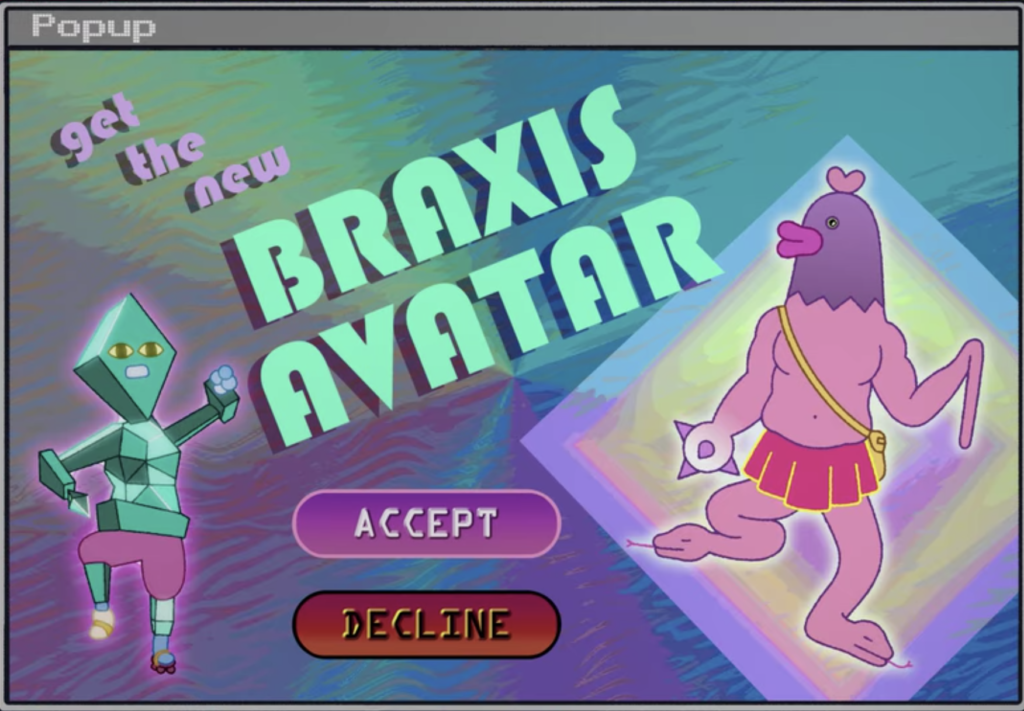
Episode 2 – “Officers and Wolves”
Guests: Anne Lamott and Raghu Markus
As Clancy prepares to enter the simulator again, his flippant disregard for basic internet safety has landed him with a distracting virus. An insistent popup ad for a “Braxis Avatar” essentially strong arms him into selecting the odd chicken headed, snake limbed creature for his next venture. While the rest of this episode doesn’t feature much in the way of occult topics, the reference to “Abraxas” is one that I imagine most viewers miss. The odd creature has a complicated history, one that is debated by archeologists as to its origin and purpose. Generally it is associated with the “Archons” of Gnosticism, though its appearance on protective amulets suggests a more varied use in mystical practice. Below is an example representation from an ancient amulet:
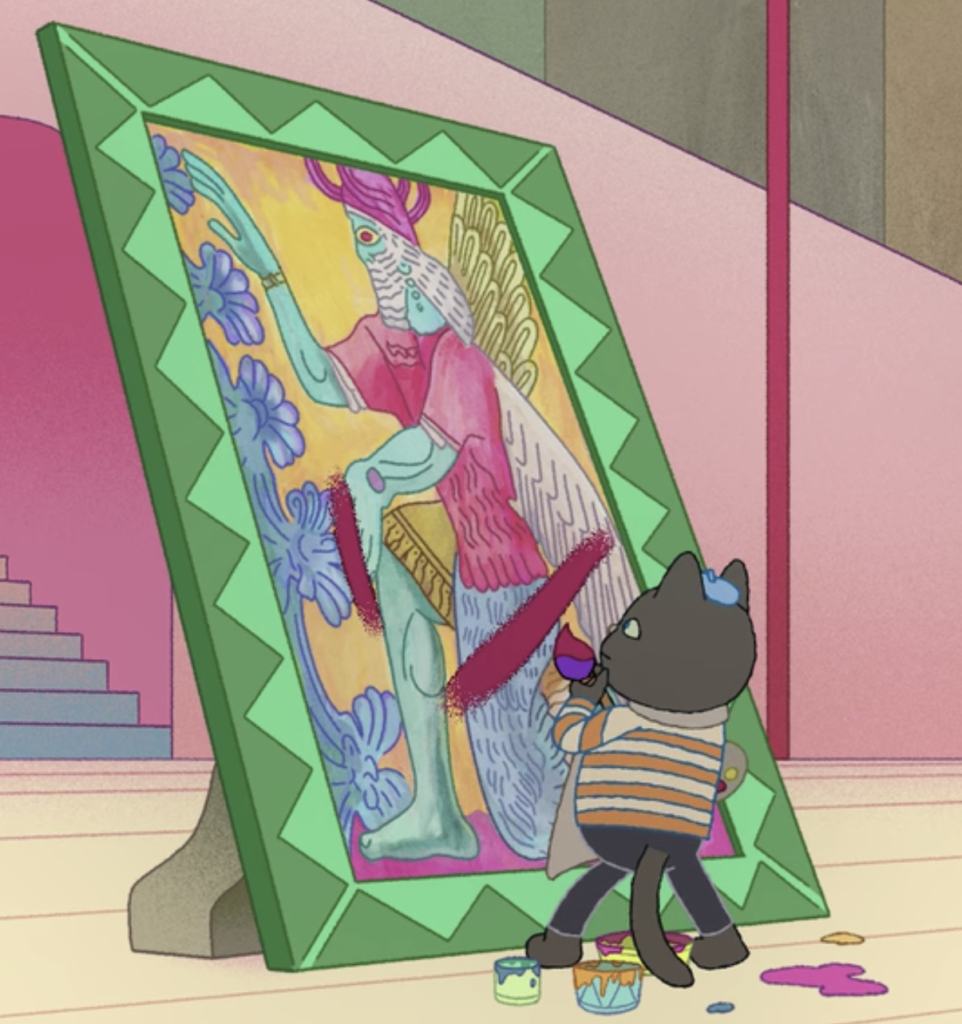
Episode 3 – “Hunters Without a Home”
Guest: Damien Echols
In this episode, Clancy follows a fish in a bowl piloting a biomechanical body and his ship of cats while searching for some ice cream. That is an absurd summary to contrast with the stellar discussion involving the advent and practice of ceremonial magick in the western world but that is exactly why this show is amazing. It breaks down the false dichotomy between the serious, profound parts of our natures and the joyful, indulgent bouts of absurdity. Life itself can be absurd and profound and each person embodies these aspects from time to time in different degrees. Artificially separating the two is detrimental to art and media. The way that The Midnight Gospel balances the irreverent and the deeply meaningful tones creates a contrast that not only grabs the audience’s attention but constantly throws a spotlight on the otherwise difficult esoteric concepts by the comparison. How successful it is in doing so varies from episode to episode and also depends on an individual’s tolerance for both exploratory spirituality and cartoon nonsense. This episode is an almost ideal balance superseded only by episode five in my opinion (as an aside, the final episode, number eight, seems to be a standout for most viewers but I didn’t find it as engaging probably due to a lack of personal experience to relate to it. Regardless, episodes three, five, and seven are the most relevant for occult and esoteric studies).
A perfect example of Midnight Gospel using this high contrast between its serious and comic elements is the image above of the cat painting. The subject is an ancient Assyrian protective spirit that reinforces the dialogue’s discussion of ceremonial magic having originated in the area of the ancient city of Nippur in modern day Iraq. The art style and subject are recognizably from the religion practiced in that area at that point in history. It’s particularly refreshing to hear an occult practitioner recognize that the seeds of western occultism are distinctly middle eastern despite their eventual migration and transformation moving westward across Europe. The guest, Damien Echols, makes another excellent point in recognizing his affinity for western occultism over eastern spirituality. Born and raised in the United States, specifically Arkansas, Echols’ cultural and religious foundation was built on a western model. Despite his deep respect for and diligent study of eastern religion and philosophy (to the point of him being ordained in Rinzai Zen) he ultimately got more out of ceremonial magic because of its basis in western culture.
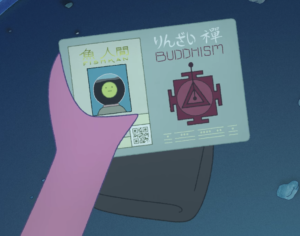
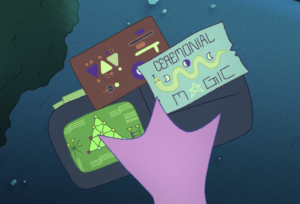
All of that being said, the historical to the personal, why is it a cat painting the image? Why is the character’s ship crewed by equally clever yet adorably distracted felines? The answer is that because everyone loves cats; they’re funny and they’re cute. That’s the reason. That’s the other reason I think that this format and mixed tone is so successful is that not everything has to mean something. Some elements are just there to be enjoyed. There’s a beautiful balance between being able to genuinely enjoy something because it’s fun and colorful but also sit down and research the signs and symbols that really do stand for a wealth of knowledge and history. There are some references in this show that are just window dressing. There are so many more that are subtle and interpretable signs relating to themes of religion, spirituality, life, death, and enlightenment. Sometimes there are both in the same frame, like the cat painting a neon colored Sumerian god (another interesting note which I’m not sure was intentional, the actual artifact the image is based on was originally painted in bright colors which have disintegrated over the centuries; read more via the link in the caption).
Another visual reference that isn’t touched on at all in the dialogue of the show is a brief view of Echols’ tools for ceremonial magic next to the ship’s wheel:
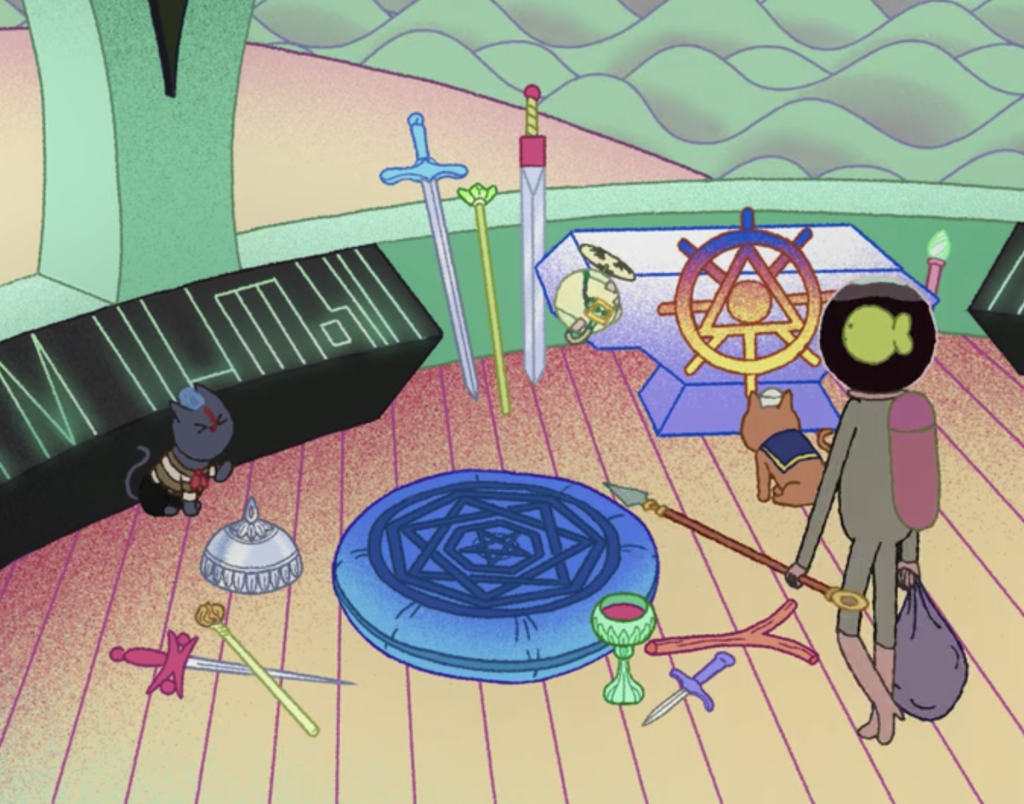
Representations of the four classical tools are spread out on the floor next to the ship’s wheel. The cup (filled with what looks like wine or blood), the wand, the sword (or athame), and pentacle (represented by the pattern on the blue cushion). There are even a few different swords and wands for variety. The silver item appears to be a bell of some sort which is another common addition to western esoteric altars. The main four will make another appearance in episode seven in the context of the Magician tarot card. The traditional icons on the Magician’s table are also the four suits for the minor arcana of the tarot deck. Here is the classic Rider-Waite version for comparison:
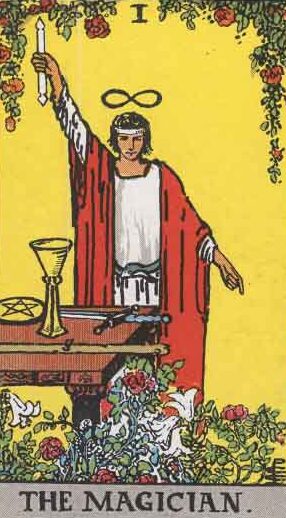
This won’t be the last time we see this figure represented in the series.
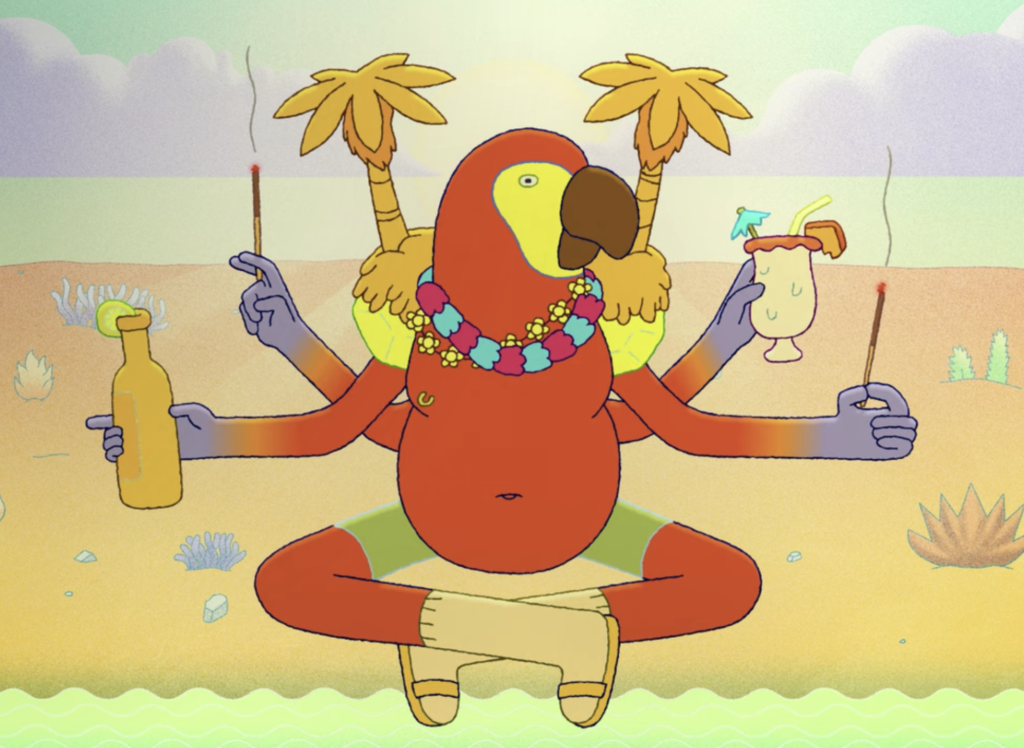
Episode 4 – “Blinded by My End”
Guest: Trudy Goodman
Clancy’s computer finds a simulated planet that it thinks he will like called “Mercurytaville”. The computer describes it as the “paradise planet” where everyone lives in harmony and indulges in hedonism. The image of one of the denizens above takes the pose of a multi-armed Hindu god implying that their harmony is the result of an enlightened, spiritual nature. The closest match I could find to the specific pose (which denotes different things depending on the number and position of the arms) was with the creator god Brahma:
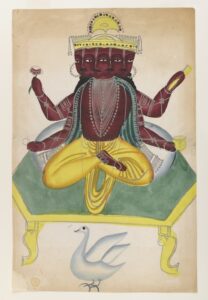
Even the name of the planet, a portmanteau of “Mercury” and “Margaritaville”, implies a connection with either the astrological facets of the planet mercury or Mercury’s Roman equivalent Hermes (namesake of Hermes Trismegistus of the hermetic occult traditions). Of course, the other half of the reference is clearly Jimmy Buffett’s “Margaritaville”. Here again the show mitigates the deeper spiritual references with a playful, contemporary cultural reference but in a way that engages and entertains rather than diminishes the former.
Clancy doesn’t get to experience this unique vision of an enlightened paradise and is instead, unknown to him, diverted to a planet more along the lines of a heavy metal album cover come to life:

Landing in a seedy tavern, asking around for the nearest orgy, Clancy clearly lacks the ability to read a room. Luckily, he falls in with a kindly “Love Barbarian” voiced by Trudy Goodman. In our world, Goodman teaches meditation, practices Theravada Buddhism, and founded “InsightLA” medication center. The conversation in the show centers around related topics and how to apply them to your life while Trudy seeks out her lost lover.
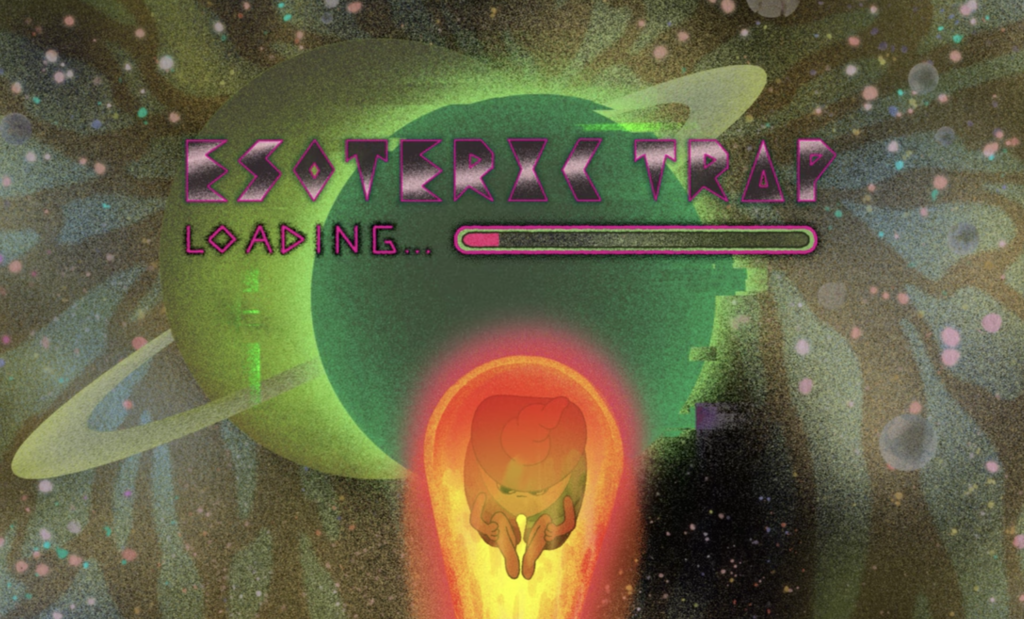
Episode 5 – “Annihilation of Joy”
Guest: Jason Louv
This is my personal favorite episode and, in my opinion, the most effective representation of the show’s raison d’être. Some of the other episodes suffer from the lack of cohesion between their audio and visual components. Taken separately they are both well done and entertaining but nowhere else do the visuals in this show justify their existence like they do here.
“Annihilation of Joy” is about the main theme running through the entire series: death and rebirth. Clancy crashes through the levels of an existential prison where characters from previous episodes, they and their planets now dead, are locked up with tiny “soul animals” attached to them by a thin thread. Clancy finally comes to a stop in the cell of the mute prisoner Bob, who bit off his own tongue in a fit of anger, and Bob’s “Soul Bird” voiced by Jason Louv (author and practitioner).
In a subsequent prison brawl, Clancy is entangled with the cord that binds Bob to Jason, and upon Bob’s death he experiences the “existential trap” that is the real prison:
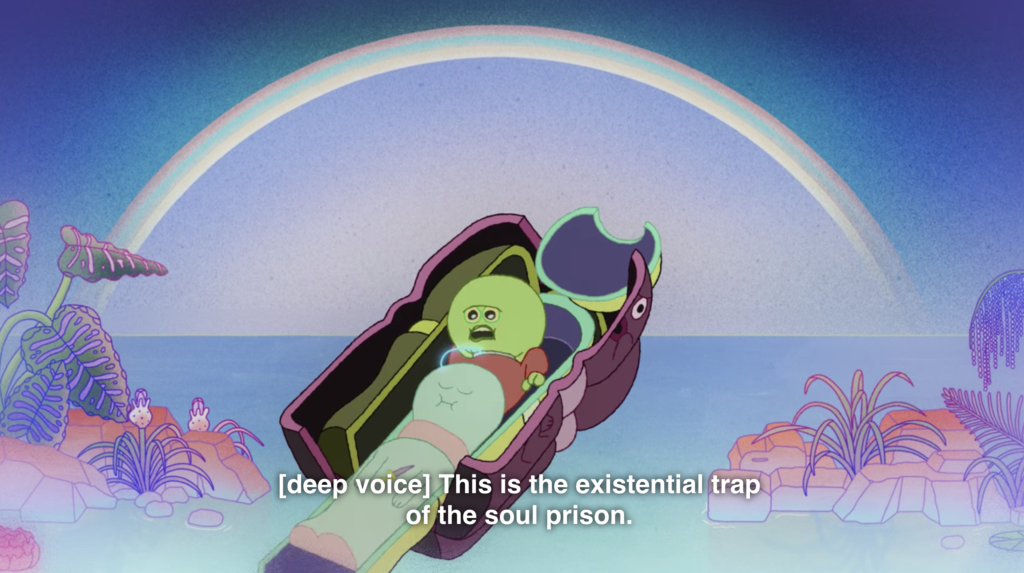
Bob then has his heart (in the form of a snapping, snarling, dog-like creature) removed from his chest by two multi-eyed figures who then place it on a scale:
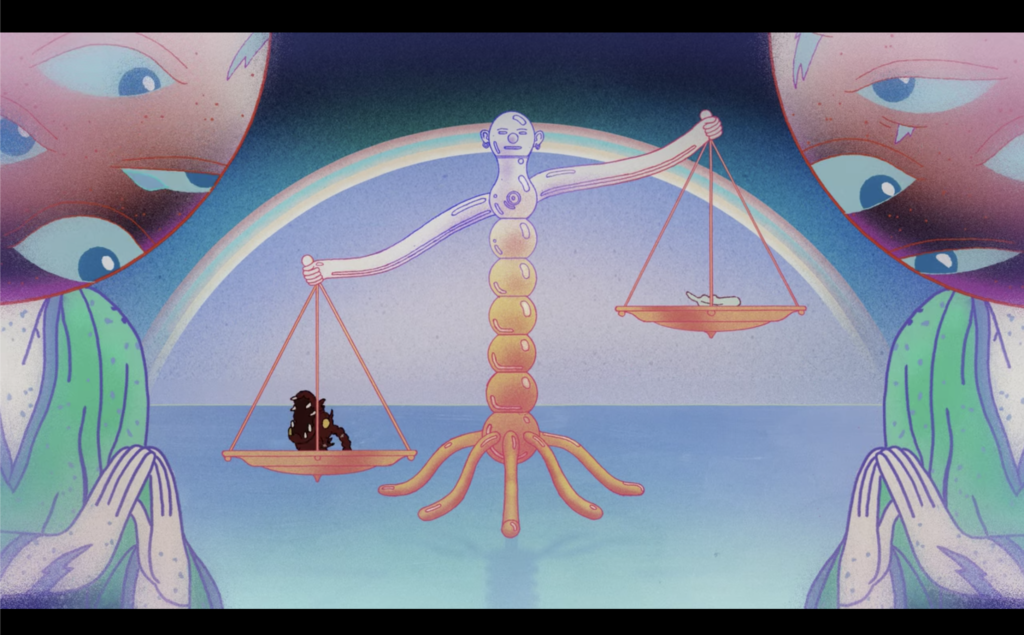
The image of the heart on the scale, weighed against a feather, is a clear reference to the same process in ancient Egyptian myth.
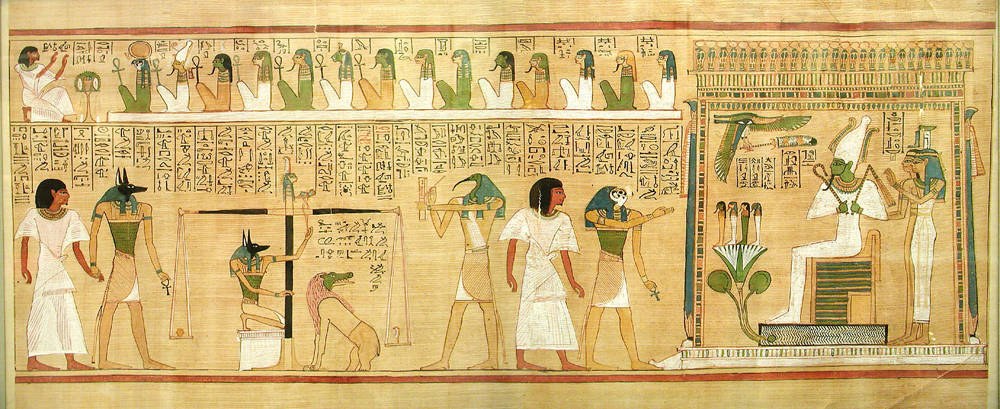
Part of the journey through the afterlife, as documented in the Egyptian Book of the Dead, was judgement. The soul’s heart was weighed against the “Feather of Truth”. If it was heavy with sin, the heart would be fed to the monster Ammit and the soul would be destroyed. While the show uses the Egyptian imagery, the fate of Bob’s soul is quite different upon his judgement. Instead of the hall of the god Osiris, Bob’s soul is in the Buddhist state of bardo. While not all Buddhists adhere to the concept, bardo is the place between life and death where the soul has an opportunity to see and learn things before they are reincarnated. This knowledge of a higher state beyond the material gives the soul a perspective to help them escape the cycle of rebirth.
Some souls are more complicated than others and Bob has to go through several iterations of his physical prison escape in order to learn what he needs to lighten his heart and escape his spiritual prison. He lives again, he dies again, he is judged, he fails, and the cycle repeats. Each cycle is different, however, and Bob learns more in each repetition and his actions adjust accordingly.
Louv starts to explain how all spirits are connected in a sort of net configuration, where each individual soul is an intersection on the net. Everyone is connected in this way, but few realize it. Bob starts to see himself in the other prisoners and the guards who threaten him or impede his escape. He literally sees his face superimposed over others’ and this makes him change how he treats them. Instead of killing his way up the floors to the hole in the roof, Bob works with other escapees and spares the lives of the overwhelmed guards. While his final attempt results in his death once again, he has finally lived in a way that lightens his heart, calms his inner hatred and anger, and allows him to transcend the prison in a truly surprising way.

Episode 6 – “Vulture with Honor”
Guest: David Nichtern
This episode doesn’t feature much in the way of the occult other than some visual references like the one above. There is a discussion about meditation but the episode mostly serves to move along the over-world plot of the series.

Episode 7 – “Turtles of the Eclipse”
Guest: Caitlin Doughty
This is a densely packed episode in terms of occult imagery. It is designed around two thematic elements: imagery from the Rider-Waite version of the tarot deck and a traditional journey through the afterlife. It also weaves in various references to the tree of life from Kabbalah and Jungian psychoanalysis.
Clancy’s journey through the afterlife begins after he falls into his own satchel, a TARDIS-like space which contains not only piles of items but an entire populated world. Clancy meets Death incarnate, voiced by the morbidly delightful Caitlin Doughty. Doughty is a funeral director, author, activist, and founder of the “death positive” group The Order of the Good Death. After taking the (mostly) classical form of death as a black robed reaper, Doughty discusses how modern American sensibilities and misinformation about death evolved from the Civil War era and how it has impacted our relationship to our own and others’ deaths.
Doughty’s character represents the “Death” tarot card, one that is generally understood to signify change and not literal death. The cards known as the “Major Arcana” or “Trump Cards” in the standard 78 card tarot deck are generally the most recognized. The history, use, and variations of the tarot is rather long and complicated to fully express here. For just the representation in The Midnight Gospel, please note that I will be referring only to the use of tarot as an interpretive, spiritual tool as it is commonly used today in occult practices and specifically to the “Rider-Waite” version of imagery and its generally accepted interpretations.
The Major Arcana consists of 22 of the 78 cards in this standard deck. They are numbered, starting with The Fool as “0” and ending with The World as “21”, and represent a kind of life or spiritual narrative when read one after another in order. While the figures appear out of order in the episode, I will leave you to interpret their places for yourself with this in mind.
I was able to catch 12 of the 22 cards but would love to hear if anyone saw the remaining 11. Those represented include (in their order of appearance with their Rider-Waite card number listed in parentheses):
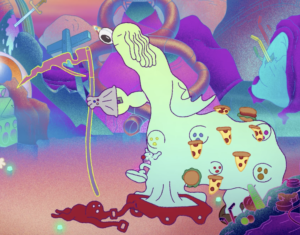

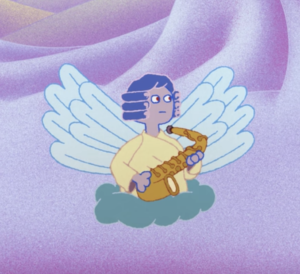
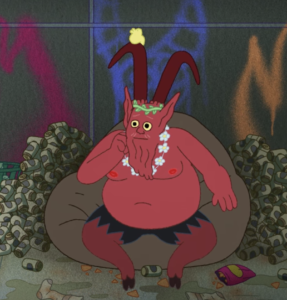
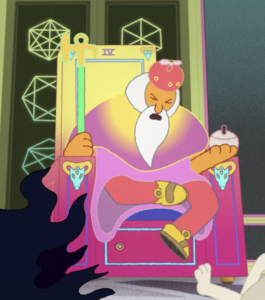
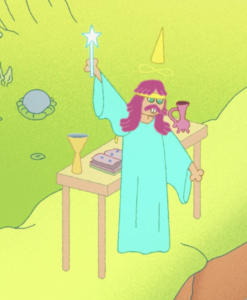
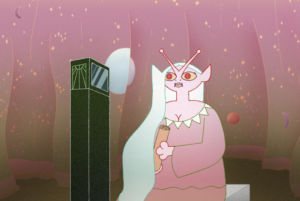
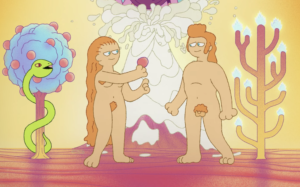
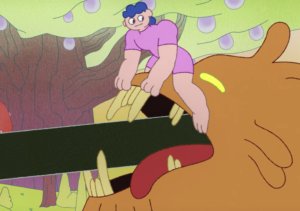
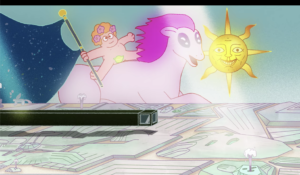
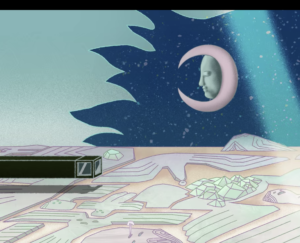
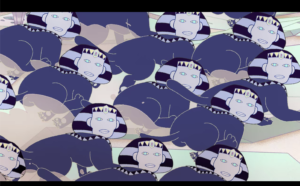
Finally, as Clancy leaves the world inside his satchel, five of the tarot figures (The Fool-0, The Emperor-4, Death-13, The Devil-15, and Judgement-20), fall together in the void before they transform into the tree of life.
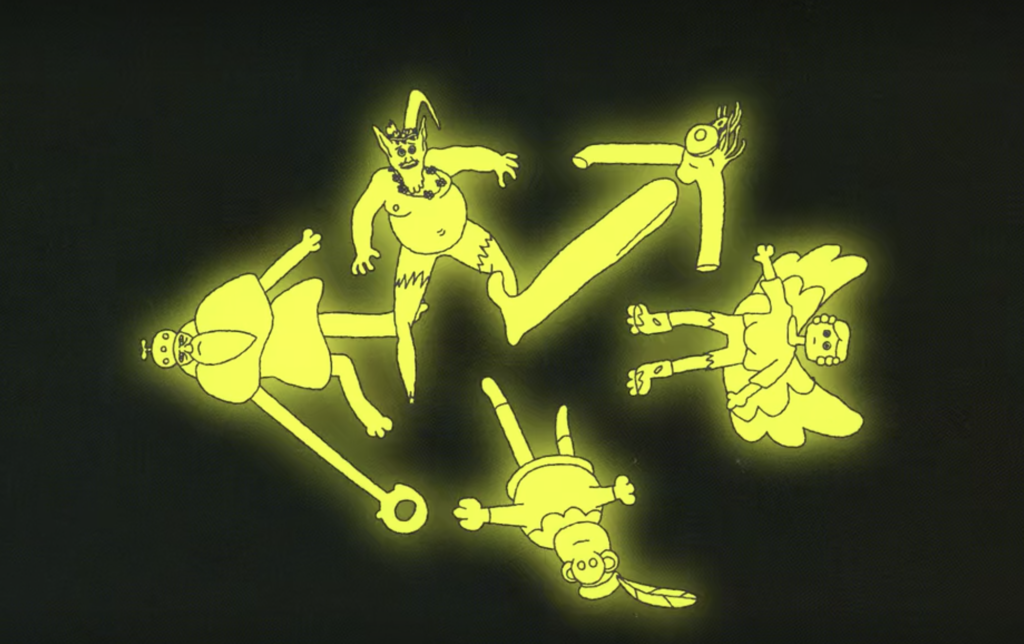
The image appeared earlier on the gates of what appeared to be heaven as well as the buttons on the elevator:

As Clancy pops out back onto the waterslide (which is what he needed the hose for), the bag itself turns into an anthropomorphic tree of life as well. Clancy inquires if the bag is “a metaphor or something” to which the bag responds with a shrug.
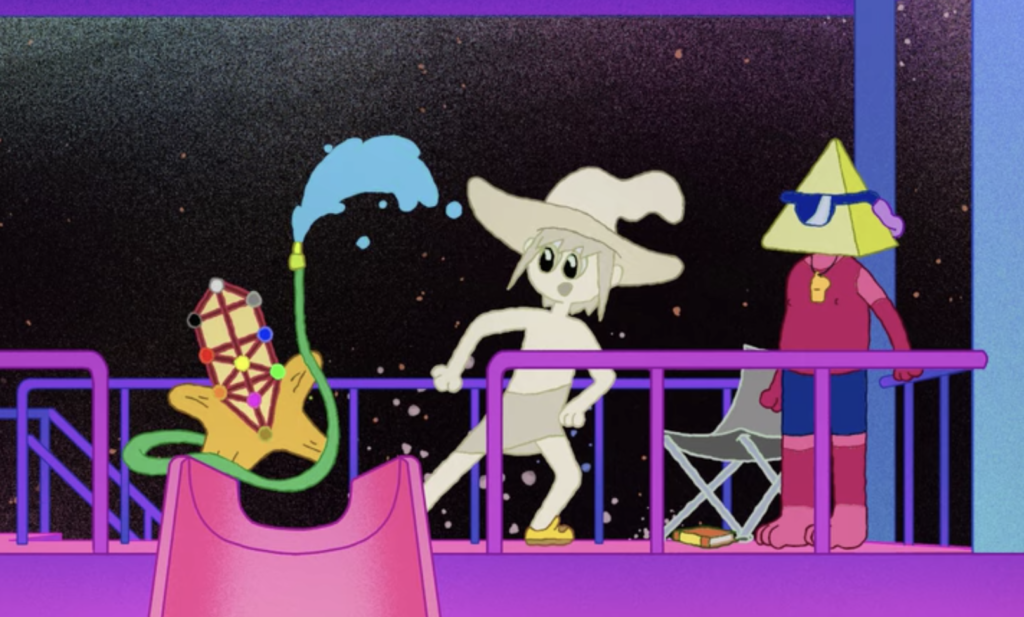
I won’t go into every possible interpretation of this episode. Each of the cards has a traditional meaning, the order that they appear in might very well have significance, and even the shape formed as the five fall into the void could be representative of a tarot spread (where the position of each card in relation to one another means something). I am personally not an expert in tarot and the practice is far from standardized. I will leave my readers to form their own interpretation. On the inclusion of the sephirot I will comment that it is unusual, though not unheard of in modern practice, to see it mixed in with the tarot. I think the strongest correlation is that both are indicative of a process or journey by which a soul grows and is enlightened. The path outlined by the Major Arcana is wildly different in content as well as function, however, from that of the sephirot. The former has more application to individual lives, both physical and spiritual, whereas the Kabbalah is decidedly focused on G*d’s relation to the physical world, creation, and the G*dhead itself. What the sephirot and the tree of life encapsulate is infinitely more complex and involved than tarot in any of its iterations. That isn’t to say that one is superior or more valid than the other, simply that adding the Kabbalah imagery to the relatively simple tarot symbology makes interpreting it definitely much more difficult. Since the two aren’t very well suited for one another, their practices don’t refer to or compliment each other, and their histories are all but completely separate, their appearance in the show likely doesn’t go any deeper than a superficial understanding of each. That being said, an enterprising practitioner might very well find a personal system that integrates the otherwise disparate practices in a way that I don’t see. I would love to hear from anyone with thoughts via email or the site’s forum (also linked at the top of the page).
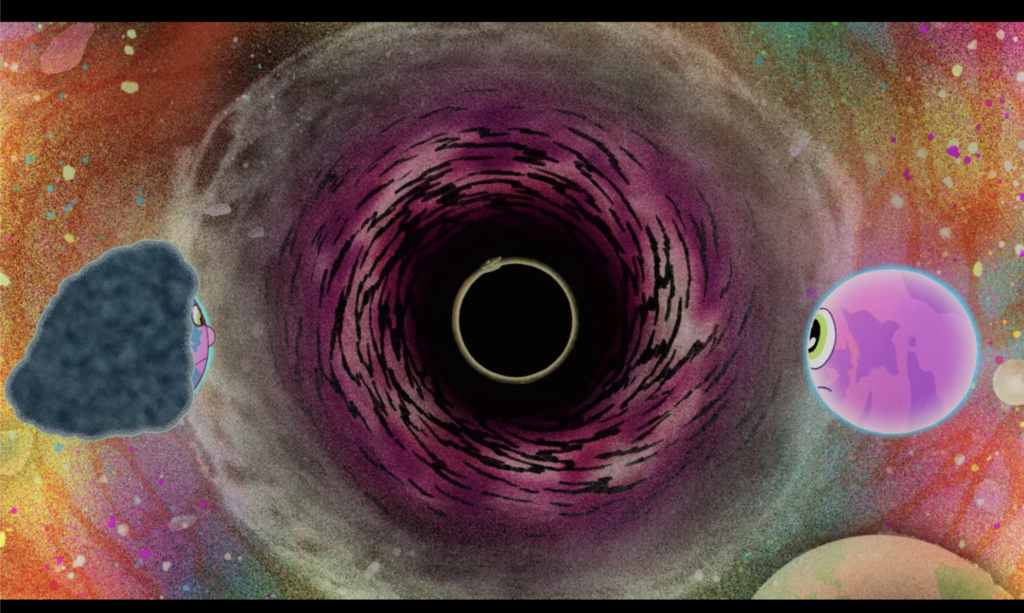
Episode 8 – “Mouse of Silver”
Guest: Deneen Fendig
The final episode I will let speak for itself for the most part. It is essentially a culmination of the themes of death and rebirth that the series has consistently used throughout. The interview is one with Duncan Trussell’s own mother who was dying of cancer at the time. Through a series of transformations, including Clancy giving birth to his own mother in a role reversal or sorts, the two end as planets (pictured above) with Clancy/Duncan’s mother dissolving into a black hole with a golden ouroboros at its center. The quintessential image of rebirth and the cyclic nature of all things, the snake biting its tail is found in almost every Western occult tradition from Hermeticism, Alchemy, Gnosticism, and more. Already a transformative symbol by the nature of the snake shedding its skin, the addition of it swallowing its own tail to create a circle (or rarely an infinity symbol to double down on the imagery) is both elegantly simple and rich in meaning.
As Clancy is thrust into the simulator one last time, his entire body entering the machine, he boards a tram with the familiar sephirot decal on its side. Taking a seat among characters spanning the season, he turns to a new face and asks “am I dead?”. The voice of the late Ram Dass replies, “Just be here now”.
That sentiment concludes the series thus far. I am infinitely impressed with the creators’ ability to balance the entertaining and artistic aspects of the show with a genuine depth of spiritual philosophy and references. Some of the visuals, like the use of the third eye, are shallower than others. There are thematic elements which suggest much deeper understanding of the philosophy on display as well. I’ve discussed at length death and rebirth which is the most obvious one and the through line for the entire season. The shoes that Clancy collects are never mentioned or expounded upon but the most obvious interpretation would be a physical representation of “walking in someone’s shoes” which is essentially what Clancy is doing through his interviews. He is collecting and experiencing alternate perspectives. The last metaphor I’d like to point out is less overt and it ties into the practical aspects of spiritual practices. In the “over-world” part of the story that takes place outside of the simulated planets, Clancy is neglecting the basic maintenance of his computer and simulating machine. Despite multiple warnings by the computer itself, and the obvious damage his negligence is causing the simulated planets, it isn’t until very late that Clancy attempts to do anything about it. At that point, the damage is more or less done. This jives with Clancy’s general personality that we glean throughout the show, especially in his avoiding his sister’s calls. In pursuing the metaphysical conversations with his spacecast guests, Clancy neglects the physical machine that makes those conversations possible. The warning to pay attention to your physical body and reality around you while seeking spiritual enlightenment is not uncommon in both Eastern and Western practices. Only the most extreme ascetics eschew everything up to and including bodily necessities like food and rest. In general, most spiritual teachers and schools advise some amount of attention paid to earthly concerns. With any luck we’ll see the consequences of Clancy’s neglect in a second season. I would certainly love the opportunity to overanalyze new episodes.
While it seems as though I went over quite a bit of the series and revealed quite a few of its secrets, I know I’ve missed or didn’t recognize more than a few. Aside from episode five’s title, “Annihilation of Joy”, the rest of the episode titles don’t have a clear meaning or correlation to me. They don’t match the corresponding podcast episode title and only a few have words even tangentially related to the episode’s content. I would love to know if there is significance behind the name of Clancy’s avatar (Nell Noheem) from episode five. It sounds like Hebrew to me but I have been unable to find anything that matches it. The meaning of the spoons and the devilish looking man who plays them is also a mystery to me. I’m not aware of spoons having any particular meaning in occult or esoteric traditions but that doesn’t mean they don’t have one. On that note, if anyone was confused by the “milking crows” in episode four, as well as in the end credits, my understanding is that it is some kind of “in-joke” from the podcast and not anything else in particular from esotericism or the like. I’m not sure if the creators intended for it, but one of the prisoners in episode five has a “soul spider” which, in addition to the setting, reminds me of the parable of “The Spider’s Thread”. Keep in mind that often symbols in the context of this kind of spiritual work aren’t meant to have only one answer or interpretation. Some things are meant to be experienced and interpreted on an individual level. Their meaning is derived as much from our personal experience and perspective that we bring to the image or symbol as anything that the creator intended. The creator may not even know what it means, having included it based on some whisper in their own mind that compelled them to express it.
If anyone has ideas or questions, feel free to visit the site’s forum and post your thoughts or send me an email!
![]()
Fair Use Disclaimer
The images and content on this page regarding The Midnight Gospel are under “Fair Use” for educational purposes as well as commentary. Below is copied from copyright.gov with additional links to relevant information:
107. Limitations on exclusive rights: Fair use40
Notwithstanding the provisions of sections 106 and 106A, the fair use of a copyrighted work, including such use by reproduction in copies or phonorecords or by any other means specified by that section, for purposes such as criticism, comment, news reporting, teaching (including multiple copies for classroom use), scholarship, or research, is not an infringement of copyright. In determining whether the use made of a work in any particular case is a fair use the factors to be considered shall include—
(1) the purpose and character of the use, including whether such use is of a commercial nature or is for nonprofit educational purposes;
(2) the nature of the copyrighted work;
(3) the amount and substantiality of the portion used in relation to the copyrighted work as a whole; and
(4) the effect of the use upon the potential market for or value of the copyrighted work.
The fact that a work is unpublished shall not itself bar a finding of fair use if such finding is made upon consideration of all the above factors.
Chapter 1 – Circular 92 | U.S. Copyright Office
Except as otherwise provided in this title, as used in this title, the following terms and their variant forms mean the following: An “anonymous work” is a work on the copies or phonorecords of which no natural person is identified as author.
More Information on Fair Use
Fair use is a legal doctrine that promotes freedom of expression by permitting the unlicensed use of copyright-protected works in certain circumstances. Section 107 of the Copyright Act provides the statutory framework for determining whether something is a fair use and identifies certain types of uses-such as criticism, comment, news reporting, teaching, scholarship, and research-as examples of activities that may qualify as fair use.



